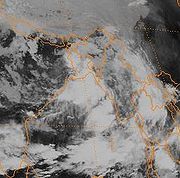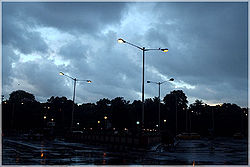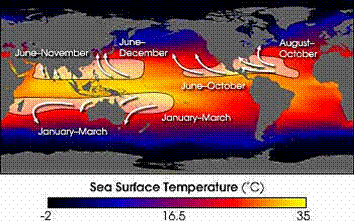
Monsoon trough
Encyclopedia

Intertropical Convergence Zone
The Intertropical Convergence Zone , known by sailors as The Doldrums, is the area encircling the earth near the equator where winds originating in the northern and southern hemispheres come together....
(ITCZ) which extends into or through a monsoon
Monsoon
Monsoon is traditionally defined as a seasonal reversing wind accompanied by corresponding changes in precipitation, but is now used to describe seasonal changes in atmospheric circulation and precipitation associated with the asymmetric heating of land and sea...
circulation, as depicted by a line on a weather map
Weather map
A weather map displays various meteorological features across a particular area at a particular point in time. Such maps have been in use since the mid-19th century and are used for research and weather forecasting purposes. Maps using isotherms show temperature gradients, which can help locate...
showing the locations of minimum sea level pressure, and as such, is a convergence zone
Convergence zone
Convergence zone usually refers to a region in the atmosphere where two prevailing flows meet and interact, usually resulting in distinctive weather conditions....
between the wind patterns of the southern and northern hemispheres. Westerly monsoon winds lie in its equatorward portion while easterly trade winds exist poleward of the trough. Right along its axis, heavy rains can be found which usher in the peak of a location's respective rainy season
Wet season
The the wet season, or rainy season, is the time of year, covering one or more months, when most of the average annual rainfall in a region occurs. The term green season is also sometimes used as a euphemism by tourist authorities. Areas with wet seasons are dispersed across portions of the...
. As it passes poleward of a location, hot and dry conditions develop. The monsoon trough plays a role in creating many of the world's rainforests.
The term "monsoon trough" is most commonly used in monsoonal regions of the Western Pacific such as Asia
Asia
Asia is the world's largest and most populous continent, located primarily in the eastern and northern hemispheres. It covers 8.7% of the Earth's total surface area and with approximately 3.879 billion people, it hosts 60% of the world's current human population...
and Australia
Australia
Australia , officially the Commonwealth of Australia, is a country in the Southern Hemisphere comprising the mainland of the Australian continent, the island of Tasmania, and numerous smaller islands in the Indian and Pacific Oceans. It is the world's sixth-largest country by total area...
. The migration of the ITCZ/monsoon trough into a landmass heralds the beginning of the annual rainy season during summer months. Depressions and tropical cyclones often form in the vicinity of the monsoon trough, with each capable of producing a year's worth of rainfall in a relatively short time frame.
Movement

Latitude
In geography, the latitude of a location on the Earth is the angular distance of that location south or north of the Equator. The latitude is an angle, and is usually measured in degrees . The equator has a latitude of 0°, the North pole has a latitude of 90° north , and the South pole has a...
during the late summer when the wintertime surface ridge in the opposite hemisphere is the strongest. It can reach as far as the 40th parallel in East Asia
East Asia
East Asia or Eastern Asia is a subregion of Asia that can be defined in either geographical or cultural terms...
during August and 20th parallel in Australia
Australia
Australia , officially the Commonwealth of Australia, is a country in the Southern Hemisphere comprising the mainland of the Australian continent, the island of Tasmania, and numerous smaller islands in the Indian and Pacific Oceans. It is the world's sixth-largest country by total area...
during February. Its poleward progression is accelerated by the onset of the summer monsoon which is characterized by the development of lower air pressure over the warmest part of the various continents. In the southern hemisphere, the monsoon trough associated with the Australian monsoon reaches its most southerly latitude in February, oriented along a west-northwest/east-southeast axis.
Effect of wind surges
Increases in the relative vorticity, or spin, with the monsoon trough are normally a product of increased wind convergence within the convergence zoneConvergence zone
Convergence zone usually refers to a region in the atmosphere where two prevailing flows meet and interact, usually resulting in distinctive weather conditions....
of the monsoon trough. Wind surges can lead to this increase in convergence. A strengthening or equatorward movement in the subtropical ridge
Subtropical ridge
The subtropical ridge is a significant belt of high pressure situated around the latitudes of 30°N in the Northern Hemisphere and 30°S in the Southern Hemisphere. It is characterized by mostly calm winds, which acts to reduce air quality under its axis by causing fog overnight, and haze during...
can cause a strengthening of a monsoon trough as a wind surge moves towards the location of the monsoon trough. As front
Surface weather analysis
Surface weather analysis is a special type of weather map that provides a view of weather elements over a geographical area at a specified time based on information from ground-based weather stations...
s move through the subtropics and tropics of one hemisphere during their winter, normally as shear line
Shear line
In a cylinder lock, the shear line , is where the inner cylinder ends and the outer cylinder begins. When a break in the pin is reached by picking, the pin will "hang" at the shearline due to the space between the inner and outer cylinder...
s when their temperature gradient becomes minimal, wind surges can cross the equator in oceanic regions and enhance a monsoon trough in the other hemisphere's summer. A key way of detecting whether a wind surge has reached a monsoon trough is the formation of a burst of thunderstorms within the monsoon trough.
Embedded depressions

Thermal low
Thermal lows, or heat lows, are non-frontal low-pressure areas that occur over the continents in the subtropics such as near the Sonoran Desert, the Mexican plateau, Sahara, South America over northwest Argentina, Australia, the Iberian peninsula, and Tibetan plateau during the warm season as the...
over the continent, and a wind surge will occur at its periphery. Such a circulation which is broad in nature within a monsoon trough is known as a monsoon depression. In northern hemisphere, monsoon depressions are generally asymmetric, and tend to have their strongest winds on their eastern periphery. Light and variable winds cover a large area near their center, while bands of showers and thunderstorms develop within their area of circulation.
The presence of an upper level jet stream
Jet stream
Jet streams are fast flowing, narrow air currents found in the atmospheres of some planets, including Earth. The main jet streams are located near the tropopause, the transition between the troposphere and the stratosphere . The major jet streams on Earth are westerly winds...
poleward and west of the system can enhance its development by leading to increased diverging air aloft over the monsoon depression, which leads to a corresponding drop in surface pressure. Even though these systems can develop over land, the outer portions of monsoon depressions are similar to tropical cyclones. In India
India
India , officially the Republic of India , is a country in South Asia. It is the seventh-largest country by geographical area, the second-most populous country with over 1.2 billion people, and the most populous democracy in the world...
, for example, 6 to 7 monsoon depressions move across the country yearly, and their numbers within the Bay of Bengal
Bay of Bengal
The Bay of Bengal , the largest bay in the world, forms the northeastern part of the Indian Ocean. It resembles a triangle in shape, and is bordered mostly by the Eastern Coast of India, southern coast of Bangladesh and Sri Lanka to the west and Burma and the Andaman and Nicobar Islands to the...
increase during July and August of El Niño events. Monsoon depressions are efficient rainfall producers, and can cause a year's worth of rainfall when they move through drier areas such as the outback
Outback
The Outback is the vast, remote, arid area of Australia, term colloquially can refer to any lands outside the main urban areas. The term "the outback" is generally used to refer to locations that are comparatively more remote than those areas named "the bush".-Overview:The outback is home to a...
of Australia.
Role in rainy season

Since the monsoon trough is an area of convergence in the wind pattern, and an elongated area of low pressure at the surface, the trough focuses low level moisture and is defined by one or more elongated bands of thunderstorm
Thunderstorm
A thunderstorm, also known as an electrical storm, a lightning storm, thundershower or simply a storm is a form of weather characterized by the presence of lightning and its acoustic effect on the Earth's atmosphere known as thunder. The meteorologically assigned cloud type associated with the...
s when viewing satellite
Satellite
In the context of spaceflight, a satellite is an object which has been placed into orbit by human endeavour. Such objects are sometimes called artificial satellites to distinguish them from natural satellites such as the Moon....
imagery. Its abrupt movement to the north between May and June is coincident with the beginning of the monsoon regime and rainy seasons across South
South Asia
South Asia, also known as Southern Asia, is the southern region of the Asian continent, which comprises the sub-Himalayan countries and, for some authorities , also includes the adjoining countries to the west and the east...
and East Asia
East Asia
East Asia or Eastern Asia is a subregion of Asia that can be defined in either geographical or cultural terms...
. This convergence zone has been linked to prolonged heavy rain events in the Yangtze river
Yangtze River
The Yangtze, Yangzi or Cháng Jiāng is the longest river in Asia, and the third-longest in the world. It flows for from the glaciers on the Tibetan Plateau in Qinghai eastward across southwest, central and eastern China before emptying into the East China Sea at Shanghai. It is also one of the...
as well as northern China
China
Chinese civilization may refer to:* China for more general discussion of the country.* Chinese culture* Greater China, the transnational community of ethnic Chinese.* History of China* Sinosphere, the area historically affected by Chinese culture...
. Its presence has also been linked to the peak of the rainy season in locations within Australia. As it progresses poleward of a particular location, clear, hot, and dry conditions develop as winds become westerly. Many of the world's rainforests are associated with these climatological low pressure systems.
Role in tropical cyclogenesis

A monsoon trough is a significant genesis region for tropical cyclone
Tropical cyclone
A tropical cyclone is a storm system characterized by a large low-pressure center and numerous thunderstorms that produce strong winds and heavy rain. Tropical cyclones strengthen when water evaporated from the ocean is released as the saturated air rises, resulting in condensation of water vapor...
s. Vorticity-rich low level environments, with significant low level spin, lead to a better than average chance of tropical cyclone formation due to their inherent rotation. This is because a pre-existing near-surface disturbance with sufficient spin and convergence is one of the six requirements for tropical cyclogenesis
Tropical cyclogenesis
Tropical cyclogenesis is the term that describes the development and strengthening of a tropical cyclone in the atmosphere. The mechanisms through which tropical cyclogenesis occurs are distinctly different from those through which mid-latitude cyclogenesis occurs...
. There appears to be a 15-25 day cycle in thunderstorm activity associated with the monsoon trough, which is roughly half the wavelength of the Madden-Julian Oscillation
Madden-Julian oscillation
The Madden–Julian oscillation ' is the largest element of the intraseasonal variability in the tropical atmosphere. It is a large-scale coupling between atmospheric circulation and tropical deep convection...
, or MJO.
This mirrors tropical cyclone genesis near these features, as genesis clusters in 2-3 weeks of activity followed by 2-3 weeks of inactivity. Tropical cyclones can form in outbreaks around these features under special circumstances, tending to follow the next cyclone to its poleward and west. This is different than the Atlantic Ocean
Atlantic Ocean
The Atlantic Ocean is the second-largest of the world's oceanic divisions. With a total area of about , it covers approximately 20% of the Earth's surface and about 26% of its water surface area...
, where tropical cyclones mainly form from tropical waves which move offshore Africa, although 2010's Tropical Storm Nicole
Tropical Storm Nicole (2010)
Tropical Storm Nicole was a short-lived and asymmetric tropical cyclone that caused extensive damage in Jamaica during the 2010 Atlantic hurricane season. It was the sixteenth tropical cyclone and fourteenth named storm of the season, as well as the last of a record eight tropical storms to form in...
may have been an exception to this rule. Eastern Pacific Ocean
Pacific Ocean
The Pacific Ocean is the largest of the Earth's oceanic divisions. It extends from the Arctic in the north to the Southern Ocean in the south, bounded by Asia and Australia in the west, and the Americas in the east.At 165.2 million square kilometres in area, this largest division of the World...
tropical cyclone formation shows a hybrid of these two mechanisms.
Whenever the monsoon trough on the eastern side of the summertime Asian monsoon is in its normal orientation (oriented east-southeast to west-northwest), tropical cyclone
Tropical cyclone
A tropical cyclone is a storm system characterized by a large low-pressure center and numerous thunderstorms that produce strong winds and heavy rain. Tropical cyclones strengthen when water evaporated from the ocean is released as the saturated air rises, resulting in condensation of water vapor...
s along its periphery will move with a westward motion. If it is reverse oriented, or oriented southwest to northeast, tropical cyclones will move more poleward. Tropical cyclone tracks with S shapes tend to be associated with reverse-oriented monsoon troughs. The South Pacific convergence zone
South Pacific convergence zone
The South Pacific Convergence Zone , a reverse-oriented monsoon trough, is a band of low-level convergence, cloudiness and precipitation extending from the west Pacific warm pool south-eastwards towards French Polynesia...
and South American convergence zones are generally reverse oriented. The failure of the monsoon trough, or ITCZ, to move south of the equator in the eastern Pacific ocean and Atlantic ocean during the southern hemisphere summer is considered one of the reasons that tropical cyclones normally do not form in those regions. It has also been noted that when the monsoon trough lies near 20 degrees north latitude
20th parallel north
The 20th parallel north is a circle of latitude that is 20 degrees north of the Earth's equatorial plane. It crosses Africa, Asia, the Indian Ocean, the Pacific Ocean, North America, the Caribbean and the Atlantic Ocean....
in the Pacific, the frequency of tropical cyclones is 2 to 3 times greater than when it lies closer to 10 degrees north
10th parallel north
The 10th parallel north is a circle of latitude that is 10 degrees north of the Earth's equatorial plane. It crosses Africa, the Indian Ocean, South Asia, Southeast Asia, the Pacific Ocean, Central America, South America and the Atlantic Ocean....
.

